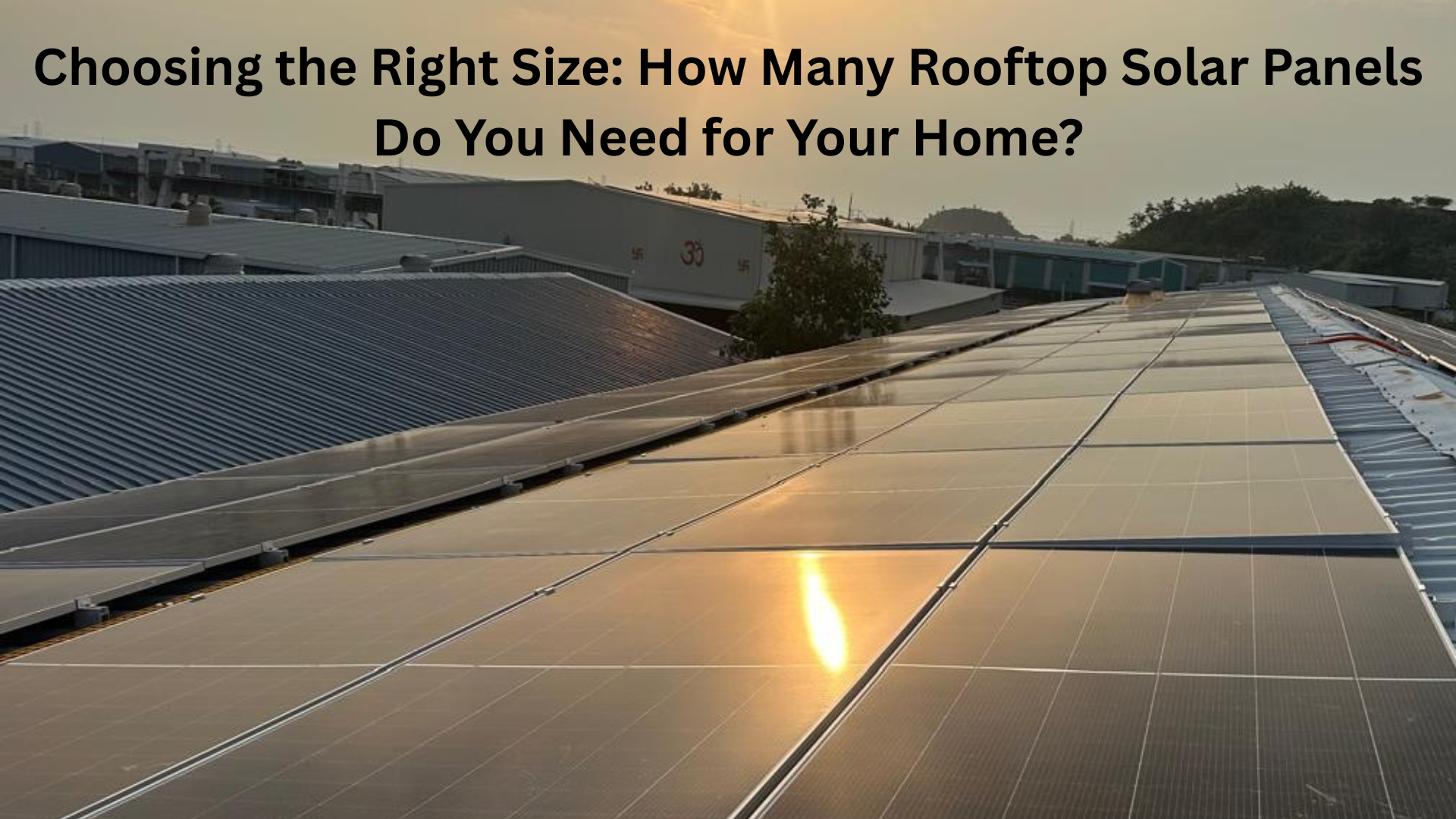The decision to install rooftop solar panels is one of the smartest long-term investments a homeowner can make. It’s an exciting step towards energy independence and significant savings. However, before you jump in, there is one crucial question you need to answer: What size system do I actually need?
Too small a system, and your savings won’t meet your expectations. Too large, and you might spend money on capacity you can’t use. The goal is to find the perfect balance.
This guide will break down the exact steps and factors that a solar professional uses to size a system, empowering you to make the most informed and trustworthy decision for your home.
Step 1: Establish Your Energy Baseline for rooftop solar

The single most important factor in sizing your rooftop solar system is your current and future energy usage.
A. Analyze Your Past Bills for Rooftop Solar Sizing
Forget your home’s square footage or the number of people living in it for a moment. What truly matters is the kilowatt-hours (kWh) of electricity you consume.
- Actionable Tip: Pull out your electricity bills for the last 12 months. This is vital because your energy use fluctuates significantly with the seasons (heavy use of AC in summer or heaters in winter).
- The Calculation: Add up the kWh consumed for all 12 months. Then, divide that total by 12 to find your average monthly consumption. This number gives you a reliable baseline for what your solar system needs to produce.
B. Factor in Future Energy Changes
A solar system lasts 25+ years. You must size it for the future, not just today. Consider these anticipated increases in energy demand:
- Electric Vehicles (EVs): If you plan to buy an EV, it will dramatically increase your home’s electricity usage. Account for this before installation.
- Electrifying Appliances: Are you planning to switch your gas stove or water heater to electric alternatives? New heat pump technology also requires dedicated power.
- Home Expansion: Adding a new room, an in-law suite, or even a pool will require more power.
Example: If your current average usage is 900 kWh/month, but you know you’ll be adding an EV (which might add 250 kWh/month), you should size your system based on a target of 1,150 kWh/month.
Step 2: Rooftop Solar System Capacity Calculation

Once you know your target energy consumption, you can determine the total kilowatt (kW) capacity your rooftop solar system needs to have.
This involves two primary location-based factors:
A. Determine Your Peak Sun Hours (PSH) for rooftop solar Efficiency
“Peak Sun Hours” is a term used to describe the average intensity of sunlight your area receives per day. A location with intense, clear skies will have more PSH than a consistently cloudy area.
- Trustworthy Source: Installers use tools like the National Renewable Energy Laboratory’s (NREL) PVWatts Calculator to get an accurate PSH for your specific pin code.
- Important Note: As a rough estimate, many sunny locations might average 4 to 5.5 PSH per day, but this varies wildly.
B. Calculate the Required System Size (in kW)
Use this simple, yet fundamental formula:
Required System Size (kW)=Peak Sun Hours (PSH)Target Daily Energy Usage (kWh)
Example Walkthrough:
- Target Daily Usage: 1,150 kWh/month ÷ 30 days ≈ 38.3 kWh/day
- Peak Sun Hours: Let’s assume your location averages 5 PSH
- Required System Size (Capacity): 38.3 kWh÷5 PSH=7.66 kW
In this example, to meet your energy needs, you require a 7.66 kW (kilowatt) rooftop solar system.
Step 3: Determining rooftop solar Panel Count

Now that you know your total required capacity (7.66 kW), the last step is figuring out how many physical panels it takes to reach that capacity. This depends entirely on the wattage of the panels you choose.
A. Choose Your Panel Wattage
Residential solar panels typically range from 350 Watts (W) to 450 Watts (W). Higher wattage panels are usually more efficient and take up less space.
- Calculation Note: Remember that 1 kW = 1,000 W. Your 7.66 kW required capacity is 7,660 W.
B. Calculate the Number of Panels
Number of Panels=Individual Panel Wattage (in Watts)Required System Size (in Watts)
Example Walkthrough (Cont.):
- Required System Size (in Watts): 7,660 W
- Panel Wattage: Let’s choose high-efficiency 400 W panels.
- Number of Panels: 7,660 W÷400 W/panel=19.15
- Final Count: Since you can’t install a fraction of a panel, you round up. You need 20 panels.
Typical Panel Requirements by System Size
The number of panels required can vary, but this table provides a useful general reference, assuming a common 400W panel:
| System Size (kW) | Approximate Energy Usage (kWh/Month) | Approximate Panels Needed (400W) | Approximate Roof Area (Sq. Ft.) |
| 3 kW | 300 – 450 kWh | 7 – 8 | 155 – 176 |
| 5 kW | 500 – 750 kWh | 12 – 13 | 264 – 286 |
| 7.5 kW | 750 – 1,150 kWh | 18 – 19 | 396 – 418 |
| 10 kW | 1,150 – 1,500 kWh | 24 – 25 | 528 – 550 |
Step 4: The Reality Check – Accounting for Limitations

The number of panels you calculate is the ideal size, but real-world factors often require adjustments.
1. Usable Roof Space and Orientation
You must evaluate your roof for structural integrity and exposure.
- Obstacles Matter: Chimneys, vents, skylights, and satellite dishes reduce the usable area for rooftop solar.
- Shading is a Killer: Any part of the roof that is frequently shaded by trees or adjacent buildings will significantly reduce the efficiency of the entire system (unless you use optimizers or micro-inverters). Your panels must be placed in unshaded areas.
- Orientation: Panels facing South (Northern Hemisphere) or North (Southern Hemisphere) receive maximum sunlight. East/West placement is feasible but may require more panels to achieve the same output.
2. The Efficiency Cushion (System Loss)
No system is 100% efficient. Your installer will factor in system loss—energy lost in the inverter, wiring, dirt, and panel degradation over time. Most installers add a 15% to 20% cushion to the capacity calculation to ensure your system meets your needs even on slightly cloudy days or after a few years of operation.
Frequently Asked Questions (FAQ)
Q1. Can I install more rooftop solar than I use?
Most utility companies allow you to install a system that offsets up to 100% or sometimes 120% of your current usage. They rarely allow systems that are grossly oversized, as the excess power you generate is often purchased by the utility at a lower rate than what you pay for power. Sizing to match your needs is best.
Q2. Do I need to buy a battery with my system?
A battery is not necessary for a grid-tied rooftop solar system that participates in Net Metering. The grid acts as your ‘battery.’ However, if your area experiences frequent power cuts or if you want to be completely energy independent, a battery (like a Powerwall) is essential for backup power.
Q3. What is the standard lifespan of a solar panel?
Most modern rooftop solar panels come with a performance warranty of 25 years. This warranty guarantees that the panels will still produce at least 80% to 85% of their initial rated power after 25 years. The physical lifespan often extends beyond 30 years.
Conclusion: Partner with a Professional
A trustworthy solar consultant will perform a detailed site survey, use specialized software to model shading year-round, and factor in local zoning rules and utility net metering policies. They will use the calculations above as a starting point and refine them to deliver a custom-sized system that perfectly balances your energy needs, budget, and roof constraints.
The right size ensures maximum electricity generation, maximized savings, and the optimal return on your solar investment for decades to come. Don’t settle for less than a perfect fit.
Do you have any questions about the specific steps, or would you like to explore the “home solar installation cost“ associated with a system of this size, or options for “solar installation in Jaipur“?


